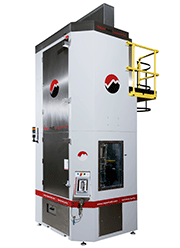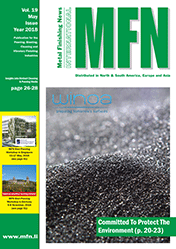E-Archive
Articles
in Vol. 19 - May Issue - Year 2018
Aerospace - Enhanced Process Control With Wet Blasting

Vapormatt Leopard Cub

Vapormatt Sabre

Vapormatt Leopard Cub with Turbine Blade
The global Vapormatt Group was established in 1978 and the Head Office is based in Taunton, Somerset in the UK. The Company is owned by the third generation of the Ashworth family. As the originators of the pressure recirculatory wet blast process, the Ashworth family has accumulated experience and expertise in this field for over 50 years. The Company designs and manufactures manual and automatic surface cleaning, peening and finishing machines, using the Vapormatt Wet Blast and High Pressure Water Systems.
In the aerospace industry, manufacturing precision is key and commercial success depends on meeting strict quality and safety requirements. Surface preparation and finishing, for new parts or for component repair and reconditioning, is just one of many crucial production processes that is widely used in the aerospace sector. Offering a range of possible applications, OEMs have specified the use of various technologies to achieve different benefits. In order to conform to established specifications, any surface finishing equipment must be able to offer great control and, more importantly, repeatability of results. Wet blasting has historically been used for a diverse range of applications and, through several years of research and development, is among some of the most controllable surface finishing techniques available. -Tim England, Head of Sales and Marketing.
What is wet blasting?
Wet blasting, similarly to dry blasting, is the use of an abrasive media and compressed air to achieve a desired finish on a chosen surface.
However, unlike dry blasting, wet blasting uses a third element – liquid – to enhance the levels of surface finish that can be achieved. Developed in the early fifties by the Ashworth family; the introduction of liquid allowed component manufacturers to achieve much more consistent and uniform finishes with the water offering a cushioning effect. Wet blasting offers great versatility as users can control various flows and pressures to make the processing of several substrates and components of various complexities much easier.
By altering the parameters to offer a processing environment that is either very aggressive or delicate the blast slurry can flow over components to achieve a range of finishes. Typically, aerospace users will benefit from a controlled peening effect on turbine and fan blades to achieve a gentle and uniform abrasion on composite frames and blades in preparation for bonding or painting.
There are also environmental benefits to using the wet blast process. In certain aerospace applications, such as the removal of abradable coatings, wet blasting can reduce or completely eliminate the use of harsh chemicals. For large overhaul sites the reduction of chemicals is not only a good cost-saving but also an effective way to protect the environment. As a result, wet blasting is well-established for the removal of paint from aircraft wheels where substrate damage can mean replacing the whole component.
Getting it right
In the aerospace industry, the complexity of wet blasting machines can range from very simple manual cabinets all the way up to fully integrated and highly automated production scale solutions. However, in all cases, there is a need to understand some basic design principles in order for the process to work consistently.
Some basic areas to check are in the cabinet design itself. The nature of any blasting environment means the machines are subject to high wear. To avoid this, leading wet blasting companies will look to use abrasion-resistant materials in all areas that come into contact with the blast slurry. This also extends to the surrounding cabinet where subtle changes such as the elimination of any shelved areas and limited use of threads can make maintenance and general upkeep of the machine a much easier task.
Accessibility is also an important consideration for users in the aerospace sector. With most wet blasting systems having a large sump to hold the pumping systems and slurry, some suppliers will require either expensive pits to be dug into the production floor or a staged platform built around the machine. Not only will this add to the cost of installation, but there will also be issues surrounding the loading and handling over heavy components such as fan blades. One patented innovation now available is a low-level sump that offers the same consistency of processing as alternative machines, but with a much lower loading height, making accessibility easier and throughput higher.
Controlling the process
At the core of all wet blasting systems is the slurry. It is the "life blood" of the process, with the pumping system its "heart". However, failing to control the concentration of this slurry can impinge on consistency if not done correctly.
Depending on the application, users will typically look to hold a concentration of 15-20% abrasive media; however, this will be continually fluctuating as media breaks down, leaving smaller particles in the process along with potential contaminants from the component being processed. To control this, aerospace manufacturers are opting to install elutriation towers into their wet blasting systems. As another patented innovation, these elutriation towers can calibrate and condition the slurry to ensure a very high media quality by removing particles that are not of the right size from the machine.
Based on Stokes’ law, elutriation towers can be set at 1 mesh size lower than the rating in the Federation of the European Producers of Abrasives (FEPA) specification. Controlling the consistency of slurry is a particularly important element when wet peening turbine or fan blades, as a change in concentration will affect the intensity levels and potential integrity of the components.
Constantly measuring concentration is another important control element. Advanced wet blasting machines come with accurate flow meters, used to detect the slightest drop in concentration. These advanced meters will continually be monitoring slurry concentration, whereas some machines may only do this every few hours. During this time, the concentration can drop significantly, causing great differences in the overall finish of the component.
However, monitoring is not simply enough. With continual information being fed back to inbuilt HMI’s pertaining to the slurry concentrations, water pH, air flows to individual nozzles and wear on abrasive hoses and soap concentrations, advanced wet blasting systems are able to run for extended periods of time with minimal user interference. Innovations include automatic abrasive and soap dosing for controlling concentrations, automated adjustment of air and slurry pressures to ensure each nozzle is of the same process intensity, and wear testing to help plan services and preventative maintenance.
Maintenance
To ensure the prolonged life and continued use of any blasting system, it is important to maintain and monitor the wear inside the cabinets and critical parts. As wear will happen over a period of time, it could potentially go unnoticed until a significant drop in surface finish can be seen. At this point, manufacturers will see scrappage rates go up and on-time deliveries go down as components may need to be reworked.
By upgrading or specifying a wet blasting machine to include self-monitoring, systems will alert manufacturers to even the slightest amount of wear and be able to advise when parts should be replaced. With a range of add-ons and optional features available, old and existing wet blasting machines can be retrofitted to bring greater process control and, ultimately, improved component quality to the aerospace industry, where meeting specifications is a key factor for success.
Summary
In the aerospace industry, wet blasting suppliers have to be able to offer highly controlled systems that can reliably and repeatedly provide the standard of finish that is demanded by OEM’s and MRO companies.
The wet blasting process was established as being originally crude in nature. As production methods and technologies have improved, wet blasting manufacturers have had to develop new and innovative ways to offer this control. A key differentiator in the provision of these developments is not only how well they work, but also how easily they can be incorporated into existing, perhaps outdated, wet blasting machines.
Vapormatt is a specialist solutions provider dedicated to wet blasting technology. We have experience in a range of aerospace applications across the globe with installations at both OEM and MRO level. Our ability to control the process using patented technologies has made us an approved supplier for several blue chip firms. The quality of surface finishing we can provide is not only consistent but always improving. This is why Vapormatt wet blasting machines are able to stay ahead of the competition and offer great advantages to the aerospace industry.
For Information:
Vapormatt
Monarch Centre, Venture Way
Priorswood Industrial Estate, Taunton
Somerset, TA2 8DE, England
Tel. +44.1823.257976
Fax +44.1823.336446
E-mail: sales@vapormatt.com
www.vapormatt.com




























